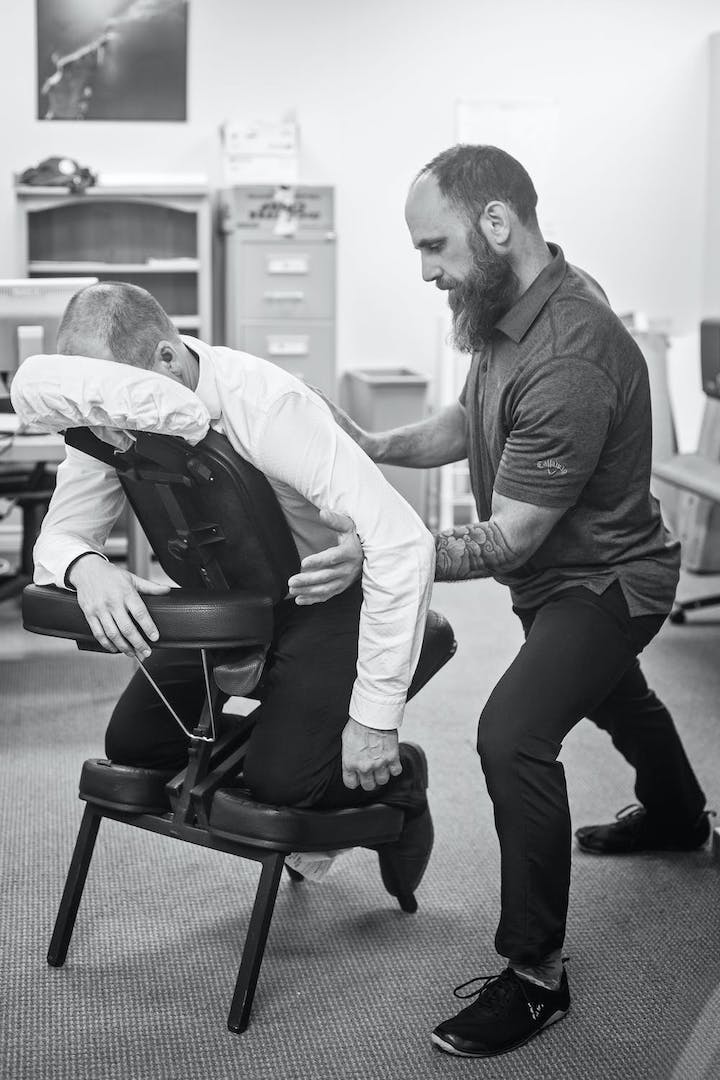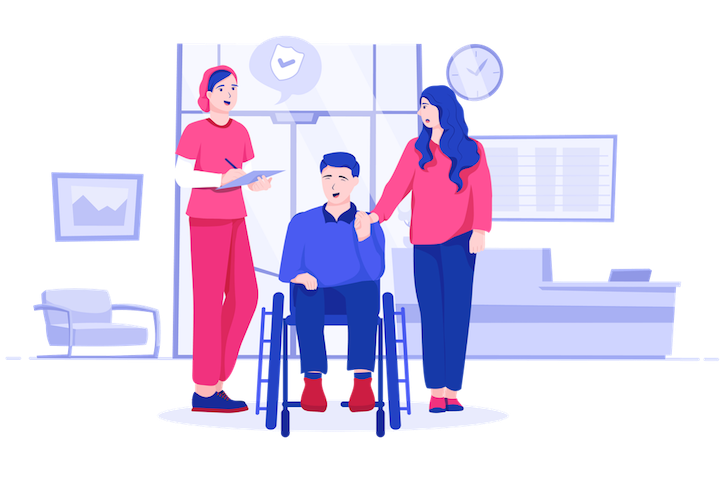

Are you looking for an effective way to manage spinal cord injury? Physical therapy has been widely used in the rehabilitation of individuals suffering from spinal cord injury, and it can be an effective tool for recovery.
Despite the range of treatments available, many people remain unaware of the power of physical therapy and what it can do when combined with other therapies. In this article, we’ll explore the role that physical therapy plays in spinal cord injury management, including its benefits, types of treatments, and how it works alongside other medical professionals.
We’ll also discuss home exercise programs, outcomes and recovery rates, self-care strategies and ongoing support from a physical therapist. By understanding all these aspects of physical therapy for spinal cord injury management, you will gain insight into how this treatment can help improve your quality of life. For more details about every aspect of physiotherapy, check out our complete guide.
Understanding the complexities of dealing with an injury to the spine is a challenging endeavor, and it’s important to recognize how much of an impact physical therapy can have on your recovery journey.
Early diagnosis and prevention strategies are essential for managing spinal cord injuries, and physical therapists can play a critical role in this process. They can provide guidance on proper body mechanics, assistive devices, mobility aids, therapeutic exercises, and other treatments that are necessary for optimizing movement and function while minimizing pain.
Physical therapists will also assess postural alignment, joint range of motion, strength challenges, and any altered sensation or reflexes that may be present due to the injury. By working closely with physicians and other healthcare professionals over time to maximize a patient’s potential for recovery from their spinal cord injury, physical therapists can be invaluable members of the rehabilitation team.
Have you ever wondered what the benefits of physical therapy are? Physical therapy can help improve and maintain physical abilities, manage pain, as well as provide emotional support.
Let’s take a closer look at how physical therapy can be used to manage spinal cord injury.
With an allusion to the biblical story of Samson, regaining physical abilities after a spinal cord injury can be likened to rebuilding strength with the help of a Delilah-like therapist.
As part of this process, physical therapists often use balance training and functional training to help improve and maintain physical abilities. Balance training can involve simple exercises such as single leg stands or more complex activities like walking on uneven surfaces.
Functional training is designed to strengthen muscles that are needed in everyday life, such as those used for transfers or standing up from a seated position. By incorporating these types of exercises into an individual’s rehabilitation plan, physical therapists can help their patients regain muscle control and mobility while also improving overall balance and coordination.
 Photo Credit: Gustavo Fring
Photo Credit: Gustavo Fring
Additionally, incorporating balance and functional training into routine exercise helps ensure that any improvements made are sustained over time by providing ongoing reinforcement for skills already acquired.
In conclusion, the role of physical therapy in spinal cord injury management is paramount when it comes to improving and maintaining physical abilities. Physical therapists use specific techniques such as balance training and functional training to aid individuals in regaining strength following a traumatic event or illness.
By utilizing these strategies during rehabilitation sessions, physical therapists can help empower their clients with practical skills that will allow them to resume day-to-day activities with confidence and grace.
Navigating pain after a spinal cord injury can be an arduous journey, but physical therapists can offer invaluable guidance to help patients manage their discomfort. Through mind-body connection and lifestyle modifications, physical therapists can provide comprehensive treatment plans that are tailored to the individual needs of each patient.
Physical therapy treatments for pain management are designed to reduce the intensity of the pain and improve the quality of life for individuals with spinal cord injuries. Therapists use a variety of techniques including exercise, breathing exercises, relaxation methods, heat/cold therapy, electrical stimulation and manual therapy in order to reduce muscle tension and spasms that may be causing pain.
 Photo Credit: Stephanie Allen
Photo Credit: Stephanie Allen
In addition to these treatments, physical therapists will also discuss ways to make lifestyle modifications such as changing diet or getting adequate rest that can help improve symptoms associated with chronic pain.
Physical therapists strive to empower people living with spinal cord injuries by teaching them how to take control of their health and well-being through proper self-management strategies.
If you want to know how pain management and injury prevention can be done in general, see our guide to how physical therapy can help it.
Living with a spinal cord injury can be an emotional rollercoaster, but physical therapists can provide much-needed support every step of the way. They’re well equipped to help you build resilience and inner strength, develop healthier coping strategies, make lifestyle modifications that increase satisfaction and reduce anxiety, and strengthen your relationships with family and friends.
Physical therapy isn’t just about healing the body, it’s also about supporting emotional well-being. Your therapist will work closely with you to identify areas of distress or emotional conflict or any other psychological issue and develop strategies for managing them effectively. This includes helping you adjust to changes in your life, communicating more effectively with loved ones, developing greater self-awareness and building confidence in yourself.
With their guidance, you can learn how to manage stressors in a healthy manner while enjoying greater peace of mind and overall quality of life.
Exploring the types of physical therapy treatments for spinal cord injury management can be like navigating a maze – tricky, yet rewarding. Physical therapists are an invaluable resource to help individuals with spinal cord injuries adapt and cope with their new reality.
Depending on the severity of the injury and other individual factors, there are many different approaches that physical therapists might take when treating these patients. One common approach is to focus on preventative measures, such as strengthening core muscles and improving posture to reduce stress on the spine.
 Photo Credit: Yan Krukov
Photo Credit: Yan Krukov
Another frequent practice is helping individuals learn functional movements that enhance their quality of life, such as exercises designed to make everyday tasks easier or more comfortable to perform. Lastly, physical therapists may also provide pain relief through manual manipulation techniques or even use electrical stimulation in some cases.
All these treatments have one crucial goal in mind: improving function while simultaneously decreasing pain levels and increasing independence for those suffering from spinal cord injuries.
Now that you know about the types of physical therapy treatments available for spinal cord injury management, let’s explore the role of physical therapists in this context.
As a patient, having a knowledgeable and experienced therapist is key to successful recovery from a spinal cord injury. Physical therapists are instrumental in helping patients manage their condition and return to an active lifestyle.
Here are four qualities that make physical therapists invaluable:
Physical therapists play an integral role in helping individuals with spinal cord injuries reach their goals for improved quality of life, mobility, strength, and overall well-being – all while meeting their unique needs as they move forward on their path toward recovery!
Working with other medical professionals can be an important part of your recovery, so it’s important to find a team of providers you’re comfortable with who understand your needs.
An interdisciplinary collaboration between physical therapists and other medical professionals can help you make the necessary lifestyle adjustments to support optimal spinal cord injury management.
From orthopedic surgeons to primary care physicians, nurses, occupational therapists and mental health counselors, these specialists are all part of a comprehensive team that works together to provide you with the best possible care.
Your physical therapist will work closely with this team to ensure that all aspects of your treatment plan are implemented correctly and that any changes in your condition or treatments are communicated quickly and effectively among all members.
In addition, the physical therapist may need to coordinate referrals for additional tests or procedures as needed.
With their specialized knowledge about spinal cord injury management, they can help you develop strategies for improving mobility and independence following an SCI.
Assistive devices can be a crucial part of regaining independence after an SCI, allowing you to perform everyday tasks with increased ease. Physical therapists are experts in selecting the right mobility aids for you and your lifestyle. These can include wheelchairs, walkers, crutches, canes, prosthetics, or orthosis that provide stability and support.
![[Crop] A lady with her wrist on a back support.](https://reliefly.com.au/wp-content/uploads/2023/06/spinal-cord-injury-back-support-crutch.jpg)
Photo Credit: Sasirin Pamai
With functional training from physical therapists, you can learn how to use these devices safely and efficiently. Physical therapy is also important for building strength and balance with adaptive exercise equipment, such as arm cycles or recumbent steppers, that enable you to increase muscle tone and coordination without compromising safety.
Other assistive devices may include braces or splints that provide additional support while walking or standing. Adapted vehicles may also be available so that you can independently drive yourself around town or on longer trips if necessary.
With a personalized home exercise program, you’ll be able to stay on track with your rehabilitation journey and ‘step up’ your recovery goals!
Physical therapy has been proven to play a vital role in the management of spinal cord injuries and developing an effective home exercise program is key. Exercise guidelines tailored to your individual condition help ensure that you’re engaging in safe activities and muscle strengthening exercises appropriate for your stage of recovery.
This custom-made exercise plan can consist of activities such as stretching, aerobic conditioning, flexibility, balance training and education about proper body mechanics. A physical therapist can use this plan to provide guidance while also teaching safety precautions and how to modify exercises as needed.
Home exercise programs are an essential component of any spinal cord injury rehabilitation process, allowing individuals to reach their greatest potential in the comfort of their own homes.
By taking part in an effective home exercise program, you can unlock the potential to achieve your recovery goals and make tangible progress towards wellness.
Setting goals is an important part of recovering from a spinal cord injury and physical therapy can help you develop realistic rehabilitation strategies that will enable you to reach them. Outcomes differ depending on the severity of the injury as well as other factors such as age and general health, but with the right support, you can make great strides in your recovery.
Physical therapists are experts at helping patients find ways to adapt their lives after sustaining a spinal cord injury. With their guidance, custom exercise programs can be tailored to individual needs and abilities so that maximum results are achieved in a safe manner. Physical therapy also helps improve mobility which is essential for daily living tasks like dressing, showering, cooking or cleaning.
It also enables people with spinal cord injuries to regain independence by teaching them how to use adaptive equipment like wheelchairs or scooters if necessary. Additionally, physical therapists often provide psychological counseling which has been proven beneficial for many patients struggling with depression caused by the life changes that come with having a spinal cord injury.
Taking part in regular physical therapy sessions along with having an effective home exercise program is key to making meaningful improvements in outcomes and recovery following a spinal cord injury.
Self-care is a crucial part of the recovery process, and it’s essential to take time for yourself – after all, you can’t pour from an empty cup.
After a spinal cord injury, self-care is even more important as physical therapy may not always be sufficient to support full recovery.
Taking a holistic approach that incorporates lifestyle changes such as getting adequate rest and nutrition, exercising regularly, and finding ways to reduce stress can help with recovery from SCI.
Physical therapists play an important role in helping those with SCI develop effective self-care strategies by providing customized guidance on how to incorporate lifestyle changes into daily life.
This could include advice on how to get enough exercise while managing pain or developing better habits around nutrition that are tailored to individual needs.
By working closely with physical therapists, individuals are able to find sustainable solutions that work best for them and their unique needs when it comes to self-care following SCI.
Following a spinal cord injury, providing ongoing support and follow-up is key for successful self-care and recovery.
Physical therapists are essential in helping individuals with SCI develop an active lifestyle and create lifestyle modifications that will help them manage their condition over time. The physical therapist can provide guidance and education on exercises that are tailored to the individual’s needs, as well as assist them in setting realistic goals to work towards.

Physical therapists also monitor progress to ensure safety and effectiveness of treatments, while providing encouragement and motivation throughout the process. They also provide advice on alternative activities such as yoga or aquatic therapy that may be beneficial for managing symptoms.
Furthermore, physical therapists can collaborate with other health care providers such as occupational therapists or psychologists to give more holistic care for those struggling with a spinal cord injury.
Physical therapy is an important part of any patient’s long-term recovery plan after a spinal cord injury, offering ongoing support and follow up every step of the way.
You may be wondering what the cost of physical therapy treatments is. Well, it varies depending on your insurance coverage and access to resources.
For example, a case study of one individual with spinal cord injury in Seattle found that after their insurance covered most of the costs, they still had to pay an additional $50 out-of-pocket per treatment session.
On the other hand, if you have limited access to financial resources or don’t have health insurance at all, there are community programs available to help cover the costs of physical therapy treatments.
In any situation, accessibility and affordability are key components when considering physical therapy for spinal cord injury management.
You may have heard about physical therapy for acute injuries, but did you know that it can also help with chronic pain?
Through a carefully tailored exercise program and muscle strengthening techniques, physical therapists can reduce or eliminate the chronic pain you’re experiencing.
Like a beautiful dance, the therapist will take your body through movements that reduce tension and relax tight muscles. This provides relief from aches and pains in a way no pill could ever do.
With their expertise and guidance, you’ll be able to get back on track to living your best life!
If you’re a caregiver for someone with a spinal cord injury, you’re not alone. There are plenty of resources to help provide emotional support and quality care.
Look into online forums and message boards dedicated to helping caregivers connect with one another, as well as organizations that offer advice on how to give the best care possible.
You can also contact your local hospital or doctor’s office for information about physical therapy programs that can help manage your loved one’s recovery process.
Don’t be afraid to reach out – getting the right support is essential for providing the best care possible.
You have the power to take charge of your spinal cord injury management and make a difference in your life. With physical therapy, you can regain strength, function, and mobility.
Physical therapists will help you develop an individualized plan tailored to your needs. But it doesn’t end there; self-care is essential for long-term recovery.
Stay positive, work hard with your medical team, and keep up with home exercise programs to achieve the best possible outcomes. You can do this: don’t give up hope and focus on what’s achievable — you can get back to living an active life again!
There are no results matching your search.
Reset